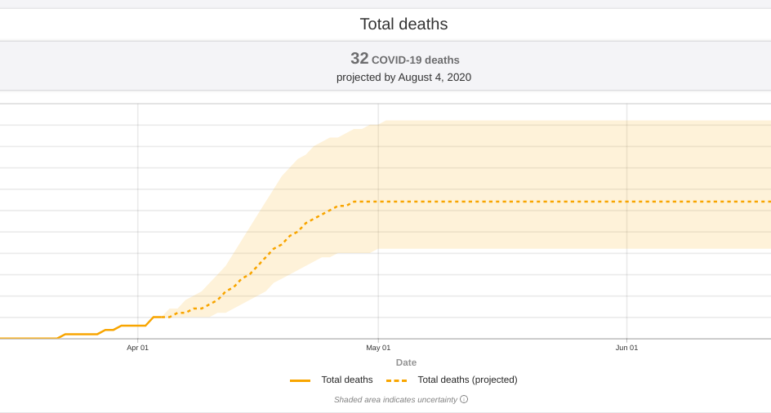
THIS POST HAS BEEN UPDATED AS OF APRIL 6
MANCHESTER, NH – Data is the key driver of how we are responding to COVID-NH, and while data can sometimes be unsettling, it can also be used for good — to get out in front of projected outcomes.
A widely shared study by Institute for Health Metrics and Evaluation (IHME) has been updated over the weekend. On April 5 IHME updated their projections citing more data and better models. They are basing scaled back numbers and better outcomes for NH and the U.S. due to more accurate data gathering and continued success of social distancing.
Key methodological and data updates are summarized below, as well as major results; more detailed information in the form of technical appendices will be published online by Tuesday, April 7.
Currently, the forecast shows that New Hampshire has adequate hospital resources and the number of projected deaths has been scaled back from its original number of 337 to 32.
WHAT HAS CHANGED AND WHY
Compared with IHME’s release on April 2, the current predictions indicate the same peak date for daily COVID-19 deaths in the U.S. – April 16 – but some states have seen shifts to earlier timing of COVID-19 peak deaths. At this peak date, the country’s daily COVID-19 deaths are now estimated to reach 3,130 (estimate range of 1,282 to 7,703) (see below) – again, similar to the April 2 release. Updated national projections for cumulative COVID-19 deaths through the first wave are lower than our April 2 model, with an estimate of 81,766 total COVID-19 deaths (estimate range 49,431 to 136,401).
| Prediction measure for COVID-19 deaths | Predictions from our April 5 release (today) | Predictions from our April 2 release | Change of average values since the April 2 release* |
| Peak date for daily deaths | April 16 | April 16 | 0 days |
| Daily deaths at peak date | 3,130 (1,282 to 7,703) | 2,644 (1,216 to 4,136) | ↑ 485 deaths |
| Cumulative deaths through first wave | 81,766 (49,431 to 136,401) | 93,531 (39,966 to 177,866) | ↓ 11,765 deaths |
*Change estimates do not include uncertainty; they are only based on the average value. If prediction values’ uncertainty intervals (the numbers reported in parentheses) overlap a lot across different releases, changes in these estimates are not considered substantively different.
[Editor’s note, April 6: The data chart is dynamic and updates daily which changes projections. You can click the chart below for the most updated information. Use the drop-down menu to search by state.]
APRIL 1, 2020: BELOW IS THE ORIGINAL POST WITH PROJECTIONS THAT ARE NOW OUTDATED
The projection below assumes New Hampshire residents maintain social distancing, with schools and nonessential businesses closed and the governor’s “Stay at Home” order still in effect.
With 1,018 available hospital beds in NH and 83 available ICU beds, projections show New Hampshire will experience a shortage of 88 hospital beds and 84 ICU beds during the projected peak time of need as of the March 31 data.

The number of deaths projected for New Hampshire based on April 1 data is 338, expected to reach that peak death toll around June 16.

On March 20 New Hampshire DHHS Commissioner Lori Shibinette acknowledged the greatest challenge to New Hampshire healthcare providers is the acute shortage of supplies and the toll it is taking on a statewide response to “flattening the curve” of community spread.
“The coronavirus has placed an unprecedented burden on our healthcare system, and signs of strain are showing,” said Shibinette. “Everyone who works in healthcare wants to test New Hampshire residents who have symptoms of COVID-19. Testing capacity at the State Public Health Laboratories (PHL) and commercial testing companies is not the issue. However, the challenge for our providers and first responders is national shortages in PPE, nasal swabs and retesting agents. Healthcare providers require access to these supplies to collect a specimen for testing. Until national supply chains are able to meet the demand for testing supplies, New Hampshire, like all states, will be forced to limit testing to those most at risk of severe symptoms and those healthcare employees who are critical to ensuring we can serve our residents’ health needs.”
In a March 27 interview on WMUR’s Close-UP, Gov. Chris Sununu acknowledged the expectation of a medical surge, and also said President Trump’s desire to get the country back to business by Easter is more hope-building than reality-based.
“The worst is probably still yet to come. We’re going to have a medical surge, and it’s going to be very serious. We want people to understand that,” Sununu said.
“I think Easter is a little optimistic, but I think [President Trump] does have that big responsibility of making sure people have hope, that they’re going to get through this,” Sununu said.







